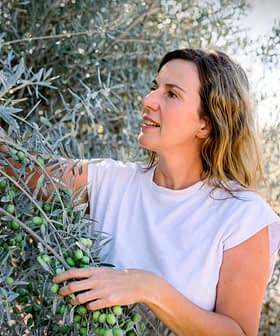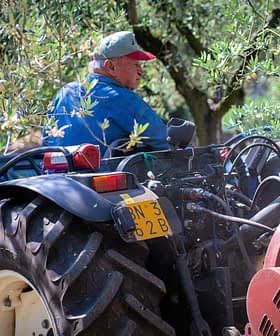It is difficult to overstate how important California is to United States agriculture.
According to the 2023 Feeding the Economy report, nearly 13 percent – $1.1 trillion (€1.0 trillion) – of the United States’ agricultural output comes from California.
We will continue to get these short burst periods of heavy rainfall, but droughts are not going away anytime soon. We need always to be planning for the next drought, even when it’s currently raining outside.
The Golden State is the largest agricultural producer in the U.S. by a wide margin. Texas and New York, second and third, combine to produce as much agricultural output as California.
The state is also responsible for virtually all U.S. olive oil production, with the California Olive Oil Council, a trade association, estimating that the Golden State produces between two and four million gallons (7.5 to 15 million liters) each year.
See Also:State-of-the-Art Irrigation Management Leads to Rising Yields in CaliforniaAs a result, water is top of mind for many farmers, including the state’s olive growers, and an increasing point of tension between rural and urban Californians, especially after years of intense drought.
According to the California Department of Water Resources (DWR), agriculture accounts for approximately 40 percent of the state’s total water use and about 80 percent of all developed water, which is controlled and managed for various purposes in California.
The state’s wet winter has lifted virtually all of California out of drought, according to the U.S. Drought Monitor. Still, officials are wary of improving agricultural water use efficiency to meet the state’s water needs.
“It’s important to understand that all regions in California are vulnerable to climate change, and their vulnerabilities are often interconnected, including in agriculture and water management,” Sabrina Cook, DWR’s water use efficiency implementation section manager, told Olive Oil Times.
She said that some of the responsibility for improving water efficiency falls on the agricultural water providers, the largest of whom must submit management plans that include a description of the best professional practices.
In the fertile San Joaquin Valley, which comprises the southern half of the state’s Central Valley, authorities are already tightening water regulations, which some have speculated could spur dryland olive cultivation in the region.
Mike Anderson, a climatologist at DWR, warned that the state’s wet winter is the result of current atmospheric conditions and should not be viewed as a long-term reprieve from drought.
“While climate drivers like El Niño change weather patterns that impact California, each year water supply and flood and drought risk are driven by the timing, pace and scale of atmospheric rivers,” Anderson told Olive Oil Times.
He explained that when large storms come close together, the pace is accelerated, and flooding tends to occur. On the other hand, drought conditions occur when California misses out on these storms and has more warm, dry days in winter.
“Reservoirs and groundwater provide a buffer to the dry conditions that can happen in a single dry year,” he said. “Multiple dry years tend to lead to greater drought impacts.”
Caitlin Peterson, the associate director and a research fellow at the Public Policy Institute of California’s Water Policy Center, confirmed that ample winter rainfall alleviated the drought but warned this may only be a reprieve.
“Thanks to 2023’s impressive winter and this year’s continued rainfall,” she told Olive Oil Times. “This is great news for agriculture and the state’s water systems.”
However, Peterson added that all indicators point towards more frequent, longer dry spells and larger swings in intensity between periods of drought and rain in California’s future.
“We will continue to get these short burst periods of heavy rainfall, but droughts are not going away anytime soon,” she said. “We need always to be planning for the next drought, even when it’s currently raining outside.”
As California braces for more rain, the question arises whether this helps refill aquifers, reservoirs and water basins.
See Also:Corto Bets on Olives as Crop of The Future in Changing Sacramento Valley“For refilling reservoirs, a high-volume, short-duration storm is as good as any,” Peterson said. “Our reservoirs are in pretty good shape overall at the moment; all but a few have more water in them than the historical average for this time of year. That is a stark difference from where we stood in February 2022.”
“Unfortunately, ‘flashy’ weather events like this are not as helpful for refilling underground aquifers,” she added. “For recharge to happen, the water needs to have some residence time, meaning it has to hang around for a while so it has time to percolate down through the soil.”
When soils are saturated with water, additional water runs off into waterways or drainage systems instead of percolating down to the water table.
“Some of this can be stored in our reservoirs and released later in the season to be used for groundwater recharge, but this brings its challenges because reservoir operators also have to think about managing flood risk, hydropower and ensuring enough supplies for other purposes,” Peterson said.
As rain continues to pound the state, concerns about potential damage arise, with some worrying that high-volume, short-interval storms create more damage to the infrastructure and crops than provide help.
“As California sees more precipitation falling in shorter, more intense periods, DWR is working with federal, state and local partners to collaborate and coordinate opportunities to enhance groundwater recharge when the larger storms come through and update reservoir operations,” Anderson said.
“This pattern of more punctuated storms separated by warm spells will become more common during our wet season,” he added. “Flood impacts to infrastructure and crops depend on “the timing, pace and scale of atmospheric river storms.”
Bekele Temesgen, a land and water use scientist at DWR, believes that education is critical to improving water use efficiency among the state’s farmers and emphasizes the use of free tools such as the California Irrigation Management Information System (CIMIS).
CIMIS is a network of automated agro-climatic weather stations that collect weather data, such as solar radiation, air temperature, wind speed and relative humidity and calculate reference evapotranspiration.
Temesgen said CIMIS helps farmers save water, energy and money by informing them to apply the right amount of water at the right time.
“A recent study by the University of California – Berkeley found using CIMIS data saves at least five million acre-feet (six billion cubic meters) of water per year in agriculture,” Temesgen told Olive Oil Times. “This translates to a monetary saving of at least $1.5 billion (€1.4 billion) in urban water costs for landscape irrigation.”
“In addition to these savings, using the right amount of water at the right time will improve environmental health by reducing surface runoff and deep percolation of contaminated water and help us mitigate the impacts of climate change through reducing energy use,” he added.
According to Temesgen, the data collected by CIMIS allows olive farmers to determine the crop water requirements. This can be done by multiplying reference evapotranspiration by the crop coefficient for olives available on the website.
Additionally, the state offers a series of grants to agricultural companies, including olive farmers, for investments in water-saving and efficient-use projects. Among these is a $23.3 million (€21.7 million) program offering grants to growers who limit agricultural water use.
Cook said that so far, six of these grants covering 4,317 acres (1,747 hectares) of land had been awarded, “permanently reducing demand on California’s aquifers while remaining available for flood protection, active groundwater recharge and sustainable local farming.”









